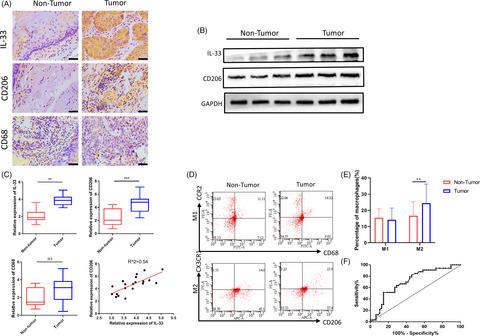当前位置:
X-MOL 学术
›
Cell Prolif.
›
论文详情
Our official English website, www.x-mol.net, welcomes your
feedback! (Note: you will need to create a separate account there.)
Oesophageal squamous cell carcinoma–associated IL‐33 rewires macrophage polarization towards M2 via activating ornithine decarboxylase
Cell Proliferation ( IF 5.9 ) Pub Date : 2020-12-10 , DOI: 10.1111/cpr.12960 Shijie Mai 1 , Le Liu 2 , Jianjun Jiang 1 , Pengfei Ren 1 , Dingwei Diao 1 , Haofei Wang 1 , Kaican Cai 1
Cell Proliferation ( IF 5.9 ) Pub Date : 2020-12-10 , DOI: 10.1111/cpr.12960 Shijie Mai 1 , Le Liu 2 , Jianjun Jiang 1 , Pengfei Ren 1 , Dingwei Diao 1 , Haofei Wang 1 , Kaican Cai 1
Affiliation

|
BACKGROUND
The tumour microenvironment primarily constitutes macrophages in the form of an immunosuppressive M2 phenotype, which promotes tumour growth. Thus, the development of methodologies to rewire M2-like tumour-associated macrophages (TAMs) into the M1 phenotype, which inhibits tumour growth, might be a critical advancement in cancer immunotherapy research. METHODS
The expressions of IL-33 and indicators related to macrophage polarization in oesophageal squamous cell carcinoma (ESCC) tissues and peripheral blood mononuclear cell (PBMC)-derived macrophages were determined. Inhibition of ornithine decarboxylase (ODC) with small interfering RNA was used to analyse the phenotype of macrophage polarization and polyamine secretory signals. CCK-8, wound-healing and Transwell assays were used to detect the proliferation and migration of ECA109 cells in vitro. The tumour xenograft assay in nude mice was used to examine the role of IL-33 in ESCC development in vivo. RESULTS
This study showed the substantially elevated IL-33 expression in ESCC tissues compared with the normal tissues. Additionally, enhanced infiltration of M2-like macrophages into the ESCC tumour tissue was also observed. We observed a strong correlation between the IL-33 levels and the infiltration of M2-like macrophages in ESCC tumours locally. Mechanistically, IL-33 induces M2-like macrophage polarization by activating ODC, a key enzyme that catalyses the synthesis of polyamines. Inhibition of ODC suppressed M2-like macrophage polarization. Finally, in vivo, we confirmed that IL-33 promotes tumour progression. CONCLUSIONS
This study revealed an oncogenic role of IL-33 by actively inducing M2-like macrophage differentiation; thus, contributing to the formation of an immunosuppressive ESCC tumour microenvironment. Thus, IL-33 could act as a novel target for cancer immunotherapies.
中文翻译:

食管鳞状细胞癌相关的 IL-33 通过激活鸟氨酸脱羧酶重新连接巨噬细胞向 M2 极化
背景肿瘤微环境主要由免疫抑制性M2表型形式的巨噬细胞组成,其促进肿瘤生长。因此,开发将 M2 样肿瘤相关巨噬细胞 (TAM) 重新连接到抑制肿瘤生长的 M1 表型的方法可能是癌症免疫治疗研究的关键进步。方法 测定食管鳞状细胞癌(ESCC)组织和外周血单核细胞(PBMC)来源的巨噬细胞中IL-33及巨噬细胞极化相关指标的表达。使用小干扰 RNA 抑制鸟氨酸脱羧酶 (ODC) 来分析巨噬细胞极化和多胺分泌信号的表型。CCK-8,伤口愈合和Transwell试验用于检测体外ECA109细胞的增殖和迁移。裸鼠中的肿瘤异种移植试验用于检查 IL-33 在体内 ESCC 发展中的作用。结果 本研究表明,与正常组织相比,ESCC 组织中 IL-33 的表达显着升高。此外,还观察到 M2 样巨噬细胞向 ESCC 肿瘤组织的浸润增强。我们观察到 IL-33 水平与局部 ESCC 肿瘤中 M2 样巨噬细胞浸润之间的强相关性。从机制上讲,IL-33 通过激活 ODC(一种催化多胺合成的关键酶)诱导 M2 样巨噬细胞极化。ODC 的抑制抑制了 M2 样巨噬细胞极化。最后,在体内,我们证实 IL-33 促进肿瘤进展。结论 本研究通过主动诱导 M2 样巨噬细胞分化揭示了 IL-33 的致癌作用。因此,有助于形成免疫抑制性 ESCC 肿瘤微环境。因此,IL-33 可以作为癌症免疫疗法的新靶点。
更新日期:2020-12-10
中文翻译:

食管鳞状细胞癌相关的 IL-33 通过激活鸟氨酸脱羧酶重新连接巨噬细胞向 M2 极化
背景肿瘤微环境主要由免疫抑制性M2表型形式的巨噬细胞组成,其促进肿瘤生长。因此,开发将 M2 样肿瘤相关巨噬细胞 (TAM) 重新连接到抑制肿瘤生长的 M1 表型的方法可能是癌症免疫治疗研究的关键进步。方法 测定食管鳞状细胞癌(ESCC)组织和外周血单核细胞(PBMC)来源的巨噬细胞中IL-33及巨噬细胞极化相关指标的表达。使用小干扰 RNA 抑制鸟氨酸脱羧酶 (ODC) 来分析巨噬细胞极化和多胺分泌信号的表型。CCK-8,伤口愈合和Transwell试验用于检测体外ECA109细胞的增殖和迁移。裸鼠中的肿瘤异种移植试验用于检查 IL-33 在体内 ESCC 发展中的作用。结果 本研究表明,与正常组织相比,ESCC 组织中 IL-33 的表达显着升高。此外,还观察到 M2 样巨噬细胞向 ESCC 肿瘤组织的浸润增强。我们观察到 IL-33 水平与局部 ESCC 肿瘤中 M2 样巨噬细胞浸润之间的强相关性。从机制上讲,IL-33 通过激活 ODC(一种催化多胺合成的关键酶)诱导 M2 样巨噬细胞极化。ODC 的抑制抑制了 M2 样巨噬细胞极化。最后,在体内,我们证实 IL-33 促进肿瘤进展。结论 本研究通过主动诱导 M2 样巨噬细胞分化揭示了 IL-33 的致癌作用。因此,有助于形成免疫抑制性 ESCC 肿瘤微环境。因此,IL-33 可以作为癌症免疫疗法的新靶点。











































 京公网安备 11010802027423号
京公网安备 11010802027423号